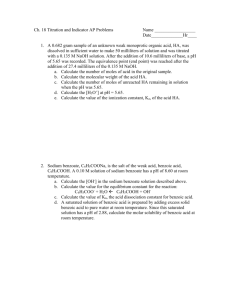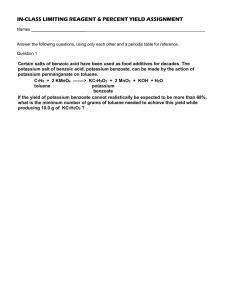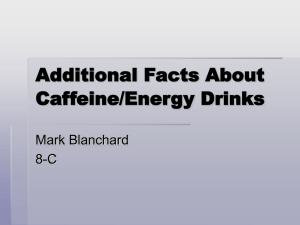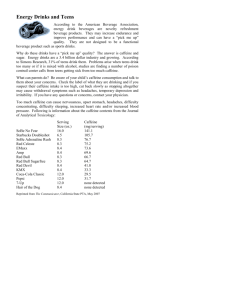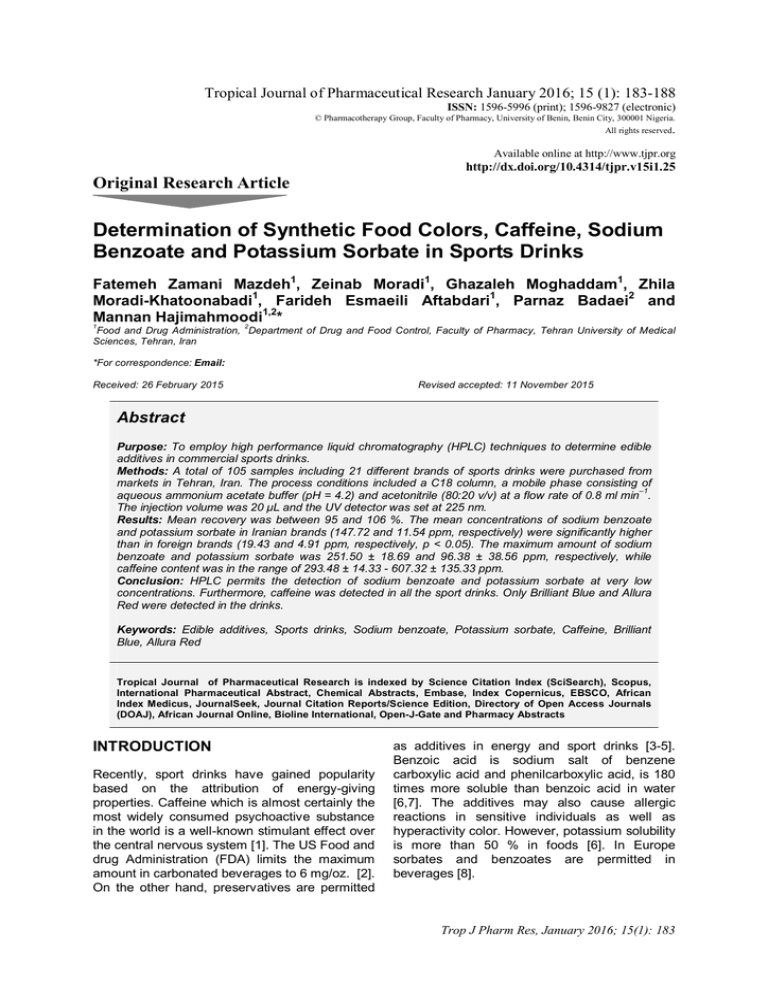
Moghaddam et al
Tropical Journal of Pharmaceutical Research January 2016; 15 (1): 183-188
ISSN: 1596-5996 (print); 1596-9827 (electronic)
© Pharmacotherapy Group, Faculty of Pharmacy, University of Benin, Benin City, 300001 Nigeria.
All rights reserved.
Available online at http://www.tjpr.org
http://dx.doi.org/10.4314/tjpr.v15i1.25
Original Research Article
Determination of Synthetic Food Colors, Caffeine, Sodium
Benzoate and Potassium Sorbate in Sports Drinks
Fatemeh Zamani Mazdeh1, Zeinab Moradi1, Ghazaleh Moghaddam1, Zhila
Moradi-Khatoonabadi1, Farideh Esmaeili Aftabdari1, Parnaz Badaei2 and
1,2
Mannan
Hajimahmoodi
*
1
2
Food and Drug Administration, Department of Drug and Food Control, Faculty of Pharmacy, Tehran University of Medical
Sciences, Tehran, Iran
*For correspondence: Email:
Received: 26 February 2015
Revised accepted: 11 November 2015
Abstract
Purpose: To employ high performance liquid chromatography (HPLC) techniques to determine edible
additives in commercial sports drinks.
Methods: A total of 105 samples including 21 different brands of sports drinks were purchased from
markets in Tehran, Iran. The process conditions included a C18 column, a mobile phase consisting of
–1
aqueous ammonium acetate buffer (pH = 4.2) and acetonitrile (80:20 v/v) at a flow rate of 0.8 ml min .
The injection volume was 20 μL and the UV detector was set at 225 nm.
Results: Mean recovery was between 95 and 106 %. The mean concentrations of sodium benzoate
and potassium sorbate in Iranian brands (147.72 and 11.54 ppm, respectively) were significantly higher
than in foreign brands (19.43 and 4.91 ppm, respectively, p < 0.05). The maximum amount of sodium
benzoate and potassium sorbate was 251.50 ± 18.69 and 96.38 ± 38.56 ppm, respectively, while
caffeine content was in the range of 293.48 ± 14.33 - 607.32 ± 135.33 ppm.
Conclusion: HPLC permits the detection of sodium benzoate and potassium sorbate at very low
concentrations. Furthermore, caffeine was detected in all the sport drinks. Only Brilliant Blue and Allura
Red were detected in the drinks.
Keywords: Edible additives, Sports drinks, Sodium benzoate, Potassium sorbate, Caffeine, Brilliant
Blue, Allura Red
Tropical Journal of Pharmaceutical Research is indexed by Science Citation Index (SciSearch), Scopus,
International Pharmaceutical Abstract, Chemical Abstracts, Embase, Index Copernicus, EBSCO, African
Index Medicus, JournalSeek, Journal Citation Reports/Science Edition, Directory of Open Access Journals
(DOAJ), African Journal Online, Bioline International, Open-J-Gate and Pharmacy Abstracts
INTRODUCTION
Recently, sport drinks have gained popularity
based on the attribution of energy-giving
properties. Caffeine which is almost certainly the
most widely consumed psychoactive substance
in the world is a well-known stimulant effect over
the central nervous system [1]. The US Food and
drug Administration (FDA) limits the maximum
amount in carbonated beverages to 6 mg/oz. [2].
On the other hand, preservatives are permitted
as additives in energy and sport drinks [3-5].
Benzoic acid is sodium salt of benzene
carboxylic acid and phenilcarboxylic acid, is 180
times more soluble than benzoic acid in water
[6,7]. The additives may also cause allergic
reactions in sensitive individuals as well as
hyperactivity color. However, potassium solubility
is more than 50 % in foods [6]. In Europe
sorbates and benzoates are permitted in
beverages [8].
Trop J Pharm Res, January 2016; 15(1): 183
Moghaddam et al
For safety reasons, there have been recent
reductions in the number of permitted food colors
but because of their low price, effectiveness and
stability they are still being used [9–11]. The lists
of permitted food colors is definitely different
between
countries
[12].
The
beverage
processing industry uses several types of food
colors, but to minimize potential toxicity, the
amounts of permitted synthetic colors used are
strictly limited [11,13]. So they are permitted and
frequently used in EU countries. However, they
are not permitted in other countries, including
Japan and USA [14].
chromatograph equipped with a gradient pump
capable of mixing four solvents, a vacuum
membrane degasser, a 20 μL loop injector and a
UV Detector (Agilent Technologies, Santa Clara,
CA, USA). Analysis was performed on an Eclipse
- XDB C18 column (150 × 4.6 mm, 5 μm). The
mobile phase consisted of an aqueous
ammonium acetate buffer (pH = 4.2) and
acetonitrile (80:20 v/v) with a flow rate of 0.8 ml
min – 1. The injection volume was 20 μL and the
UV detector was set at 225 nm. The
chromatographic system was initially conditioned
by the mobile phase until a stable baseline signal
was obtained, which needed at least 1 h.
The main objectives of this work were to evaluate
the levels of mentioned additives compounds in
105 sport drinks and by comparing the levels of
these compounds with the current available
standards.
To evaluate the synthetic colors, the mobile
phase consisted of ammonium acetate solution
(0.1 mol L-1, pH = 6.7), as solvent A and
methanol - acetonitrile (50:50, v/v), as solvent B.
A cellulose membrane with a pore diameter 0.45
μm was used to filter mobile phase A. In order to
achieve a successful resolution, gradient elution
programs were tested and the flow rate was
always kept constant at 1 ml min-1. The final
optimized gradient program was 3 % solvent B
as the initial step; then it increased linearly to 60
% in 18 min and was held for 2 min. Analysis
was performed on the UV detector with two
optimized conditions. First, the fixed wavelength
was set at 250 nm within the whole runtime to
make it easy to use for amateur operators; next,
it was programmed at 415 nm for tartrazine, 460
nm for Quinoline yellow, Ponceau 4R, and
Sunset yellow, 500 nm for Allura red AC and
Carmosine, and 600 nm for Indigo carmin and
Brilliant blue for different colorants [11].
EXPERIMENTAL
A total number of 105 samples were purchased
in accordance with the market availability, in
Tehran - Iran. The samples were collected
between December, 2013 and January. 2014.
The studied commodities were 21 different
brands of sports drinks. All stages of the
experiment were done before expiry date of the
drinks. The analyses were carried out in triplicate
for each sample.
Standards and chemicals
All solvents/chemicals used were of analytical
grade. In the study, high purity standards of
potassium sorbate (> 99 %), sodium benzoate (>
99 %), sodium salicylate (> 99.5 %), Caffeine (>
99 %), ammonium acetate (98 %), acetic acid
glacial (100 %) and HPLC - grade acetonitrile
were purchased from Merck (Darmstadt,
Germany). Deionised water was prepared by a
Branstead Easypure II system (Thermo Fisher
Scientific Inc., Waltham, MA, USA). Methanol
(Merck) was HPLC quality. Acetic acid (Merck, d
= 1.05) that was used for acetate buffer and
NaOH (Merck, 5 mol/L) that was used for
regulating pH were of analytical purity. Millipore
Milli - Q water was used in all stages of the
assay.
Chromatographic conditions
Sport drinks were filtered through 0.45 µm
membrane filter and ultrasonicated, before HPLC
analysis. Analytical separation of the caffeine,
sodium benzoate and potassium sorbate was
carried
out
by
reverse
phase
liquid
chromatography of an Agilent 1200 series liquid
Data analysis
All measurements were replicated three times to
improve the reliability of the results. Data were
analysed using statistical program for social
sciences (SPSS), version 21 (IBM SPSS Inc.,
Chicago, USA), Data are expressed as mean ±
SD. One way analysis of variances (ANOVA Dunnett T3) was used for determining significant
difference which was set at p < 0.05.
Method validation
The LOD and the LOQ were calculated as LOD =
3.3 σ/S and LOQ = 10 σ/S, where σ is the
standard deviation of the response and S is the
slope of the calibration curve. The estimate of σ
was carried out by analyzing blank samples
seven times, measuring of the magnitude of the
analytical background response and then
calculating the standard deviation of the
response. Recoveries were determined by
spiking a sport drink known to be free of all
Trop J Pharm Res, January 2016; 15(1): 184
Moghaddam et al
additives, in triplicate, with known amounts of
studied additives at final concentrations between.
and also caffeine, while in Figure 2 the synthetic
dyes resolution are illustrated.
RESULTS
The concentrations of preservatives quantified
from sports- drink samples are shown in Table 2.
Sodium benzoate was found in 14 brands at
levels ranging between 12.50 and 251.50 ppm,
(Table 2).
The analytical methodology revealed good
linearity, sensitivity, exactitude and precision.
Correlation coefficients (r2) were comprised
between 0.998 for caffeine acid and 0.999 for the
other studied factors. Limits of qualification and
quantification are presented in Table 1
respectively.
Recovery values were between 95 % and 106 %
for studied additives at determined spiked levels.
The developed method was successfully in the
evaluation of the mentioned additives. Figure 1
shows the chromatograms of a standard solution
containing sodium benzoate, potassium sorbate
Moreover, 15 brands didn’t have any potassium
sorbate. The levels of sodium benzoate and
potassium sorbate in Iranian brands (147.72 and
11.54 ppm, respectively) were significantly more
than foreign studied brands (19.43 and 4.91 ppm
respectively).
Also, methods to evaluate levels of coloring in
foods for quality control are currently made by
the TLC method. The mean concentration of
colors in each sample group is presented in
Table 3.
Table 1: Recovery data for the additives in sports drinks
Additive
Sodium benzoate
Potassium sorbate
Caffein
Quinoline Yellow
Sunset Yellow
Carmoisine
Ponceau 4R
Allura Red
Indigotine
Brilliant Blue
Calibration Data
y=121.3x-56.82
y=69.61x+36.64
y=39.31x+9.87
y = 38.71x - 6.952
y = 47.20x - 13.56
y = 62.40x - 16.47
y = 21.98x - 6.095
y = 70.08x - 10.09
y = 56.71x - 12.95
y = 100.2x - 19.83
2
R
0.999
0.999
0.998
0.999
0.999
0.999
0.999
0.999
0.999
0.999
LOD (ppm)
0.6413
1.1224
1.8263
0.465
0.357
0.666
0.873
0.510
0.431
0.562
LOQ (ppm)
1.9435
3.4013
5.5344
1.409
1.082
2.019
2.646
1.547
1.307
1.704
Recovery (%)
99- 102
98- 100
97- 101
96- 105
98- 106
95- 105
97- 103
95- 102
99- 101
95- 100
Fig 1: Chromatograms of a standard solution containing sodium benzoate, potassium sorbate and also caffeine.
Trop J Pharm Res, January 2016; 15(1): 185
Moghaddam et al
Fig 2: Resolution of chromatograms of synthetic dyes. 1 – Tartrazine; 2 - Quinoline yellow 1; 3 - Indigo carmine;
4 - Quinoline yellow 2; 5 - Ponceau 4R; 6 - Sunset yellow; 7 - Quinoline yellow 3; 8 - Allura red AC; 9 –
Carmozine; 10 - Brilliant blue
DISCUSSION
Additives perform a variety of useful functions in
foods that consumers often take for granted.
Some additives could be eliminated if we were
willing to grow our own food, harvest and grind it,
spend many hours cooking and canning, or
accept increased risks of food spoilage. Iranian
National Standards [15] have some stringent
rules for regulating the use of food additives. The
level of sodium benzoate and potassium sorbate
in Iranian standard (6693) [15] is 150 and 500
ppm, respectively. Therefore, based on the
achieved results, 26.66 % of samples had higher
sodium benzoate but all samples were in the
range of sorbate.
Table 2: Sodium benzoate and potassium sorbate concentrations (ppm) in different brands of sports-drink
Brand
A
B
C
D
E
F
G
H
I
J
K
L
M
N
O
P
Q
R
S
T
U
Sodium benzoate
Mean±SD
Range
24.77±0.93
24.25-26.18
12.50±16.67
24.28-33.35
21.76±2.20
18.66-23.35
18.19±1.91
16.08-21.09
0
0
0
0
28.41±5.03
23.98-36.37
0
0
0
0
0
0
0
0
0
0
242.34±24.83
202.52-285.46
231.07±23.76
204.51-257.86
250.24±36.29
226.26-304.29
251.50±18.69
226.91-269.30
144.99±77.02
17.75-218.55
138.43±17.74
123.24-150.93
163.14±18.40
131.99-178.51
105.18±6.62
94.30-111.86
95.66±109.51
18.23-173.10
Potassium sorbate
Mean±SD
Range
0
0
0
0
0
0
0
0
0
0
35.01±4.22
31.04-39.71
0
0
0
0
0
0
0
0
0
0
0
0
53.26±36.71
0-78.85
96.38±38.56
62.28-139.92
15.89±31.79
0-63.59
66.38±41.10
0-108.31
28.80±29.51
0-66.61
0
0
0
0
0
0
0
0
Trop J Pharm Res, January 2016; 15(1): 186
Moghaddam et al
Table 3: Caffeine and color concentrations (ppm) in different brands of sports-drink
Brand
A
B
C
D
E
F
G
H
I
J
K
L
M
N
O
P
Q
R
S
T
U
Caffeine
Mean ±SD
Range
345.21±114.24
174.45-389.60
443.87±36.75
403.21-496.36
354.72±117.98
179.34-431
471.42±16.57
452.46-486.96
490.76±27.86
460-526.43
446.3±23.93
425.02-481.34
490.07±49.38
425.45-549.46
459.82±19.87
437.97-478.74
453.06±15.39
426.76-463.31
441.25±15.45
420.66-456.79
484.93±17.55
465.02-511.57
464.85±15
449.66-484.42
543.78±80.99
448.26-624.28
506.21±35.65
463.14-548.39
502.65±53.29
467.16-579.93
502±49.07
449.8-574.39
607.32±135.33
503.61-836.99
514.02±36.16
499.39-572.56
293.48±14.33
284.77-314.68
547.72±223.68
235.66-776.31
531.28±37.83
504.53-558.04
For some foodstuff in the study by Mota et al
[16], sorbic acid and/or benzoic acid were
reported to range from not detected (n.d.) to 210
and n.d. to 153 mg/L, respectively. All sample
concentrations of these compounds were below
the stipulated limit of 300 mg/L for sorbic acid
alone or 150 mg/L for benzoic acid alone [16]. In
the three different samples of commercial wines,
only sorbic acid was detected below 200 mg/L,
which complied with the legislation for
preservatives in wines [16]. In another related
research which the benzoic and sorbic acids
were in quince jam, all quince jams contained
benzoic acid in concentrations ranging from
413.9.10.46 to 1501.4.2 mg of benzoic acid/kg
[17]. In another study, it was shown that the
amounts of benzoic and sorbic acid in jam were
639 mg/kg and 789 mg/kg, respectively.
Furthermore, the benzoic acid content of five of
jam samples in Ferreira et al was above the legal
limits of 500 mg/kg in Portugal [17].
Although 300 mg/day of caffeine consumption is
considered generally safe [18], there is no rapid
method to determine caffeine content of sportsdrinks. In this study, the caffeine determination in
samples was in the range of 345.21 - 543.78
ppm in Iranian sports-drink samples. However,
based on the results, other imported brands
range was 293.40 - 607.33 ppm. Therefore, it
must be asserted that caffeine amount in all
samples was higher than the standard limitation
of Iran (150 ppm) [15]. The lowest level of
caffeine was detected in the soft drink, Coca
Cola (43.71 ± 0.55), while the energy drinks
showed the highest level of caffeine (58.31 ±
Color
Color Type
Brilliant Blue
Allura Red
Allura Red
Allura Red
Mean ±SD
0
32.13±3.78
49.87±12.72
0
0
0
0
0
0
0
0
0
6.92±0.72
0
0
0
0
0
0
0
14.54±0.52
Range
0
27.37-36.48
68.84-42.54
0
0
0
0
0
0
0
0
0
7.71-6.30
0
0
0
0
0
0
0
14.92-14.17
0.35 ppm). The range of caffeine content in the
carbonated soft drinks group is between 43.71
and 45.83 ppm; while in it is from 47.56 to 58.31
ppm in the energy drink samples [19]. The mean
caffeine content of carbonated soft drink was
lower (44.52 ppm) than in the energy drinks
(52.24 ppm. It was also observed that the
caffeine level of the diet Cola (45.83 ± 1.05) was
slightly higher compared to the regular cola
drinks (Pepsi cola and Coca - cola). This is in
agreement with previous work reported by Ali et
al [20].
Food color additives are limited currently and
only seven synthetic colors are permitted under
these regulations. Color additives are used in
foods for many reasons: to off-set color loss due
to exposure to light, air, temperature extremes,
moisture and storage conditions; to correct
natural variations in colors; to enhance colors
that occur naturally; and to provide color to
colorless and “fun” foods. In the current study, all
studied colors were not present in the sports
drinks, but Brilliant blue and Allura Red were
detected. In contrast to other countries, Ponceau
4R is prohibited in USA and Norway. Brilliant
Blue is prohibited in many European countries.
Tartrazine is also forbidden in the USA and
Austria [11]. Based on the Iranian standard [15],
there was no approved limits for sports drinks.
Therefore, based on the achieved results, it
seems that approved standards need to be
revised both in terms of color type and related
quantitative limitations made, regarding further
risk assessments.
Trop J Pharm Res, January 2016; 15(1): 187
Moghaddam et al
CONCLUSION
8. Costa AC, Perfeito Lda S, Tavares MF, Micke GA.
Determination of sorbate and benzoate in beverage
HPLC provides a suitable method for the
detection of caffeine, sodium benzoate and
potassium sorbate at very low concentrations in
sports drinks. It can separate both preservatives
at one wavelength in < 10 min and involves
minimal sample preparation. The content of
potassium sorbate was below legal limits. Noncompliance with legal limits was only
encountered for sodium benzoate and synthetic
colors in some samples.
samples by capillary electrophoresis—Optimization of
the method with inspection of ionic mobilities. J
Chromatogr A 2008; 1204: 123-127.
9. Hajimahmoodi M, Oveisi MR, Sadeghi N,
Jannat B,
Nilfroush E. Simultaneous determination of Carmoisine
and Ponceau 4R. Food Anal Method 2008; 1: 214-219.
10. Tavakoli M, Shemirani F, Hajimahmoodi M. Magnetic
mixed hemimicelles solid-phase extraction of three food
colorants from real samples. Food Anal Method 2014; 7:
100-108.
11. Hajimahmoodi M, Afsharimanesh M, Moghaddam G,
ACKNOWLEDGEMENT
Sadeghi N, Oveisi MR, Jannat B, Pirhadi E, Zamani
Mazdeh F, Kanan H. Determination of eight synthetic
This work was supported by a grant from Tehran
University of Medical Sciences (no. 91–01–3317143).
dyes in foodstuffs by green liquid chromatography. Food
Addit Contam A 2013; 30: 780-785.
12. Khera K, Munro IC, Radomski JL.
A review of the
specifications and toxicity of synthetic food colors
REFERENCES
permitted in Canada. CRC Cr Rev Toxicol 1979; 6: 81133.
1. Aranda M, Morlock G. Simultaneous determination of
13. Khanavi M, Hajimahmoodi M, Ranjbar AM, Oveisi MR,
riboflavin, pyridoxine, nicotinamide, caffeine and taurine
Shams Ardekani MR, Mogaddam G. Development of a
in energy drinks by planar chromatography-multiple
green
detection with confirmation by electrospray ionization
determination of food colorants. Food Anal Method
mass spectrometry. J Chromatogr A 2006; 1131: 253-
method
for
simultaneous
2012; 5: 408-415.
14. Yoshioka N, Ichihashi K. Determination of 40 synthetic
260.
2. Barone J, Roberts H. Caffeine consumption. Food Chem
C,
Wang
microextraction
W.
applied
food colors in drinks and candies by high-performance
liquid chromatography using a short column with
Toxicol 1996; 34: 119-129.
3. Dong
chromatographic
Headspace
to
the
solid-phase
simultaneous
photodiode array detection. Talanta 2008; 74: 14081413.
determination of sorbic and benzoic acids in beverages.
15. Iranian Standard. http://isiri.ir/.
Anal Chim Acta 2006; 562: 23-29.
16. Mota FJM, Ferreira IM, Cunha SC, Oliveira MB.
4. Techakriengkrai I, Surakarnkul R. Analysis of benzoic
Optimisation of extraction procedures for analysis of
acid and sorbic acid in Thai rice wines and distillates by
benzoic and sorbic acids in foodstuffs. Food chem 2003;
solid-phase sorbent extraction and high-performance
liquid chromatography. J Food Compos Anal 2007; 20:
82: 469-473.
17. Ferreira
IM,
Mendes
E,
Brito
P,
Ferreira
MA.
Simultaneous determination of benzoic and sorbic acids
220-225.
5. Wen Y, Wang Y, Feng YQ. A simple and rapid method
for simultaneous determination of benzoic and sorbic
in quince jam by HPLC. Food Res Int 2000; 33: 113117.
acids in food using in-tube solid-phase microextraction
18. Saad B, Bari MF, Saleh MI, Ahmad K, Talib MK.
coupled with high-performance liquid chromatography.
Simultaneous determination of preservatives (benzoic
Anal bioanal chem 2007; 388: 1779-1787.
acid, sorbic acid, methylparaben and propylparaben) in
6. Koyuncu N, Uylaşer V. Determination of benzoic and
sorbic acid in turkish food using high‐ performance liquid
chromatography. J Food Process Pres 2009; 33: 361-
foodstuffs
using
high-performance
liquid
chromatography. J Chromatogr A 2005; 1073: 393-397.
19. Amos-Tautua
W,
Diepreye
E.
Ultra-violet
Spectrophotometric Determination of Caffeine in Soft
369.
7. Esfandiari Z, Badiey M, Mahmoodian P, Sarhang-pour R,
Yazdani E, Mirlohi M. Simultaneous Determination of
Sodium Benzoate, Potassium Sorbate and Natamycin
and Energy Drinks Available in Yenagoa, Nigeria. Adv J
Food Sci Technol 2014; 6: 155-158.
20. Ali MM, Eisa M, Taha Ml, Zakaria BA, Elbashir AA.
Content in Iranian Yoghurt Drink (Doogh) and the
Determination
Associated
Beverages
Risk
of
Their
Intake
through
Doogh
Consumption. Iran J Public Health 2013; 42: 915-920.
of
by
Caffeine
High
in
Some
Performance
Sudanese
Liquid
Chromatography. PJN 2012; 11: 336.
Trop J Pharm Res, January 2016; 15(1): 188


